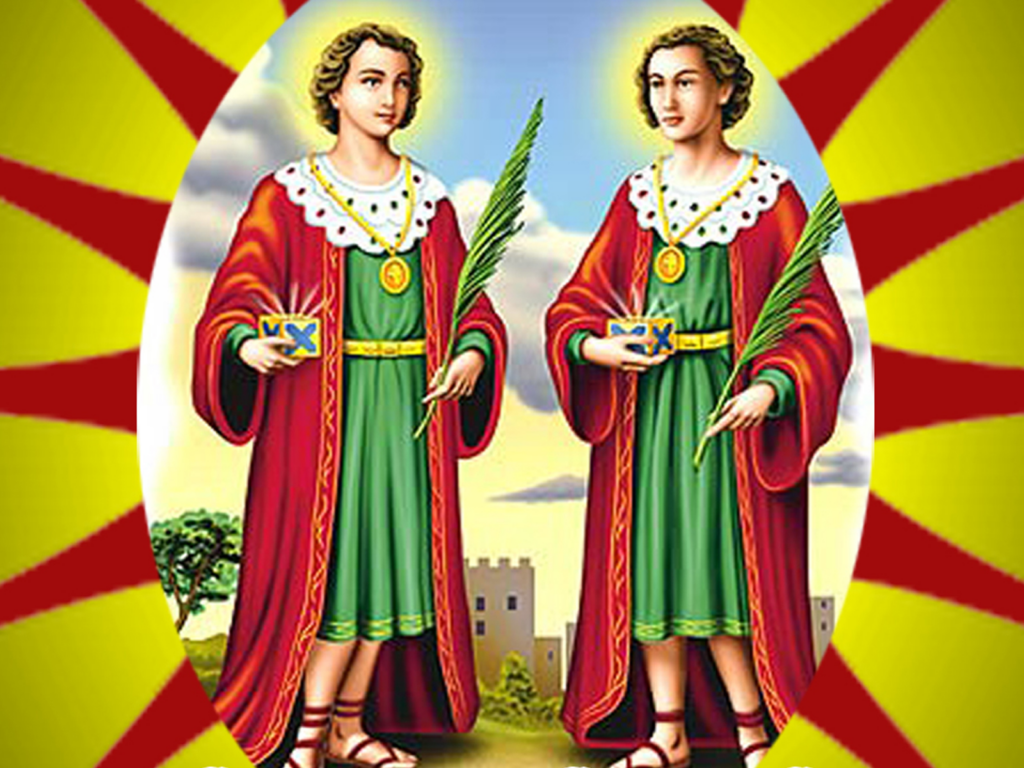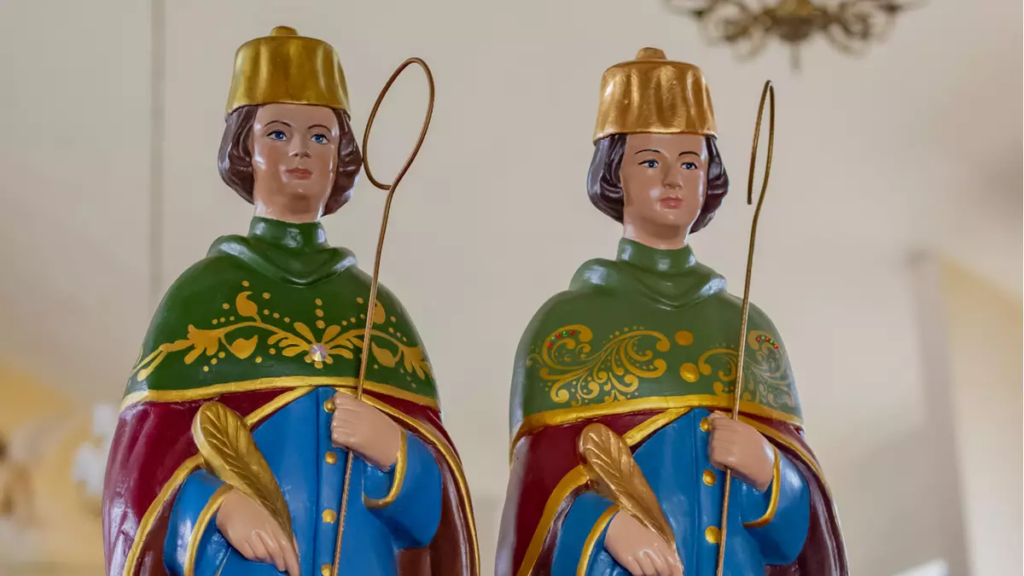In the vast pantheon of historical figures who have marked the trajectory of humanity, some stand out not only for their intellectual or political contributions, but also for their influence in the spiritual and religious spheres. Among these figures are Cosme and Damian, the twin doctors of antiquity.
Who were Cosme and Damian?
Cosme and Damian were twin brothers born in Arabia during the 3rd century A.D. They are mainly known for having been doctors and for their dedication to practicing medicine based on altruistic principles. They are believed to have lived during the reign of the Roman emperor Diocletian.
Their history is marked by their medical skills and the generosity with which they practiced them. Cosme and Damião were famous for offering free medical treatment to all those who came to them, regardless of their social background or ability to pay. This altruistic attitude made them respected and loved figures in their community.
In addition to their medical practice, Cosme and Damian are revered for having been devout Christians at a time when persecution of followers of this faith was common in the Roman Empire. Their religious devotion and selfless service led them to be considered martyrs after their death.

The story of Cosme and Damian is full of legends and miracles, many of which are recounted in hagiographies and popular traditions. One of the best-known stories is that after their execution, their bodies were transported to the city of Cyrus in Syria, where a church was built in their honor. It is said that their tombs became places of pilgrimage, where countless miracles of healing were attributed to their intercession.
Cosme and Damian are considered saints by the Catholic Church, and their feast day is celebrated on September 26. In addition, they are venerated in various Eastern Christian traditions and also in Islam, where they are known as "Qosmas and Damiyān". Devotion to these saints lives on in many parts of the world, where they are considered protectors of doctors, pharmacists and all those who work in the health sector.
Legacy and Veneration
The legacy and veneration of Cosme and Damian are fundamental aspects of their history and cultural impact over the centuries.
After their deaths, which are believed to have occurred during the persecutions of Christians under the reign of Diocletian, the cult of the twin saints grew rapidly. Their reputation as altruistic doctors and martyrs for the Christian faith inspired devotion in many of the faithful, who came to venerate them as divine intercessors and protectors.
The Catholic Church canonized them as saints, and their feast day is celebrated on September 26 by both the Catholic and Orthodox Churches. During these celebrations, faithful around the world honor the memory of Cosme and Damian through prayers, masses and processions.
In addition to Christianity, Cosme and Damian are revered in various religious traditions, including Islam. In Islam, they are known as "Qosmas and Damiyān" and are considered Muslim saints, whose graves are often visited by pilgrims seeking healing and spiritual protection.
The legacy of Cosme and Damian goes beyond the religious aspect. They have become symbols of generosity, compassion and selfless service, inspiring people of all faiths and cultures to practice charity and solidarity towards the less fortunate. Their story has also influenced the practice of medicine, highlighting the importance of holistic care and a humanitarian approach to treating patients.
Over the centuries, the veneration of Cosme and Damião has manifested itself in various ways, from the construction of churches and chapels in their honor to popular rituals and festivals. In many parts of the world, especially in countries with a Catholic tradition such as Brazil, colorful and lively celebrations mark the day of the twin saints, with sweets and food being distributed in their honor.
Cultural Representations
The cultural representations of Cosme and Damian are diverse and reflect the reverence and devotion that these saints inspire in various parts of the world.
In Christian sacred art, Cosme and Damian are often depicted as doctors dressed in robes, holding medical instruments or containers containing medicinal potions. Their images adorn churches, chapels and altars, serving as inspiration for health professionals and as symbols of hope and healing.
In addition to artistic representations, devotion to Cosme and Damião is celebrated in popular rituals and festivals, especially in countries with a Catholic tradition, such as Brazil. In these celebrations, known as "Festa de São Cosme e Damião" or "Dia dos Santos Gêmeos", communities come together to pay homage to the saints with processions, masses and lively parties.
A striking aspect of these festivities is the distribution of sweets and food in the name of Cosme and Damião. It is common for people to offer treats to children and the less fortunate as a gesture of charity and gratitude for the miracles attributed to the saints.
In addition, the popular traditions associated with Cosme and Damião vary according to the region and local culture. In some communities, folk rituals and superstitious practices are carried out in honour of the saints, while in others, charitable activities and fundraising campaigns are organized for charities.
Devotion to Cosme and Damian also extends to other forms of cultural expression, such as literature, theater and music. Many artistic works have been dedicated to the saints over the centuries, depicting their lives, their miracles and their impact on society.
Why did Cosme and Damian die?
It is believed that Cosmas and Damian were martyred during the persecution of Christians under the reign of the Roman emperor Diocletian, around 303 AD. However, specific details about the circumstances of their deaths may vary depending on historical sources and religious traditions.
According to Christian tradition, Cosme and Damian were imprisoned and subjected to various forms of torture for refusing to renounce their Christian faith. After enduring extreme suffering, including attempted execution by drowning, fire and other forms of torture, they were finally beheaded.
This account of their martyrdom and execution is widely accepted by the Christian tradition, which venerates them as martyrs for the faith. Their lives and sacrifices are remembered and celebrated annually on their liturgical feast on September 26.
What to ask Cosme and Damian for?
People who venerate Cosme and Damian often make requests related to health, healing from physical or emotional illnesses, protection for their families and loved ones, and help in difficult situations. As they are considered patron saints of doctors, pharmacists and those who work in the health field, they can also be invoked for guidance and success in matters related to medicine and health.

The way you make your requests can vary according to your religious beliefs and practices. Some choose to say a specific prayer, light a candle in their honor, make a promise or take part in a pilgrimage to a sacred site associated with Cosme and Damião.
A memory of generations
Cosme and Damian are figures venerated for their dedication to medicine and selfless service to those in need. Their legacy transcends time and cultural boundaries, inspiring generations of health professionals and believers around the world. As symbols of generosity, compassion and hope, they continue to be a source of inspiration and comfort for those seeking healing and relief in times of difficulty and adversity.
May the memory of these ancient twin doctors continue to enlighten our hearts and minds, reminding us of the importance of kindness and mutual care in our journey through life.
See also: Who was St. Jude Thaddeus, the protector of Flamengo?
April 3rd, 2024

She has a degree in Literature - Portuguese/English, and is the creator of the Escritora de Sucesso website. As a writer, she seeks to expand everyone's knowledge with relevant information on various subjects. At Trend-Topics, she brings news and content ranging from entertainment to the country's economic situation.






